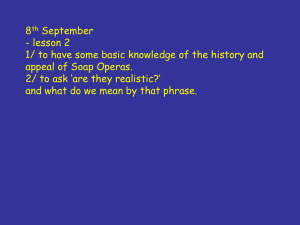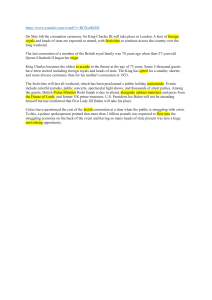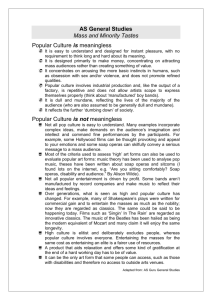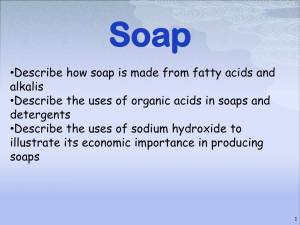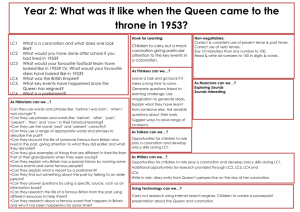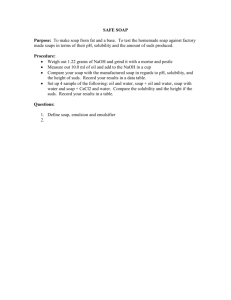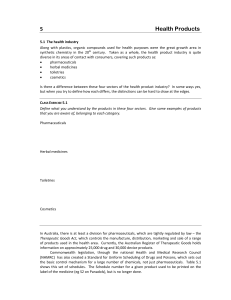Soap Operas - aslevelmedia
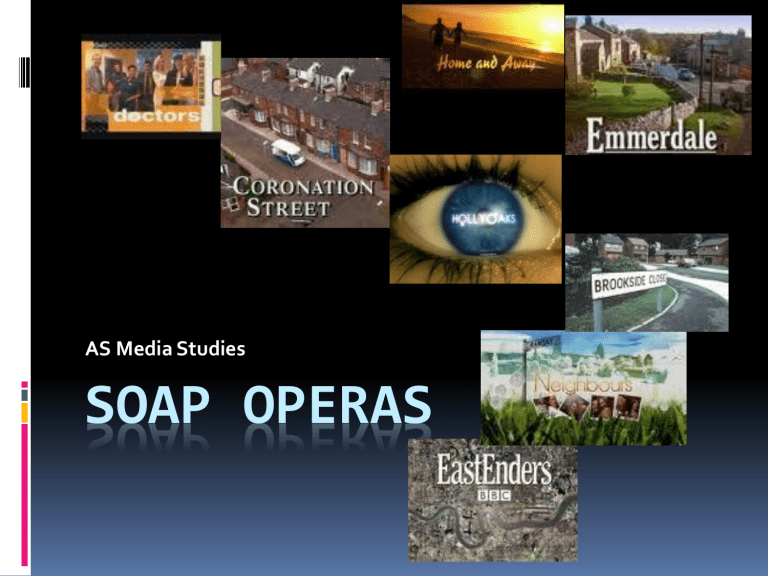
AS Media Studies
SOAP OPERAS
Soap Operas
Open-ended, multi-strand serial forms.
First developed on US radio in the 1930s.
Owes its name to the sponsorship of these programmes by major detergent companies.
Commercial television was keen to sell the promise of audiences’ regular attention to advertisers.
The hope is that audiences will stay tuned into the same channel all night.
Attractive to producers as cost can be kept down
– narrative focused on one or two key locations.
A wide appeal is generated through the several storylines that happen simultaneously.
Codes and Conventions
Long running serials concerned with real life.
Serial – storylines are carried over from one episode to the next.
The passage of time seems to reflect real time – characters age as we do.
Broadcast on a regular time slot
Viewers are in an omniscient position – we always know more than the characters and draw pleasure from this.
A wide range of characters and ‘stock’ types
No beginning or end – plots are not linear
Soaps often have controversial themes in order to aggregate audiences.
October 2002 – Eastenders – child abuse (Kat and Zoe).
Blanket publicity and coverage of this storyline on the day of this episode stressed the care taken by the programme makers with this topic.
Open narrative
There is no sense of ending
Lots of characters and a multi strand plot
Characters not usually in a marked hierarchy
(main character, cameo etc) but shift in and out of prominence depending on storyline.
Characters also shift in and out of narrative function – this week’s hero might be next week’s villain.
Open narrative
Time usually corresponds to real time within episode although it is compressed.
Episodes may make reference to real-life events going on at the same time such as Christmas.
Audiences are expected to have knowledge of long running soaps – magazines and the press often speculate about actors’ contracts and the fate of characters.
Character typology
Certain character types consistently recur to the point where they become stereotypes.
Eg. Grumpy old people and angst ridden teens are stock characters.
Pros and Cons
Soaps have advantages over more prestigious drama forms…
They are long running
Long term consequences of social issues (rape, unemployment, abuse etc) can be dealt with and resurface with the character over many years – just like real life.
However, there are also limitations…
Are they really realistic?
When have you ever heard characters in a soap discussing political campaigns/using bad language?
Gender Consumption
Studies by Gray (1992) suggest women prefer open ended narratives like soap operas.
Strong female lead characters
They focus on the private, domestic sphere
They deal with personal relationships
They contain an element of fantasy/escapism
Utopian Solution
Entertainment genres are popular because of their fantasy element and the escapism they provide from daily routines and problems.
R. Dyer (1977)
Soaps are frequently derided by critics for being full of clichés and stereotypes.
Soap viewers are often assumed to be only women, and in particular working-class housewives.
Soap viewers are characterized unfairly as naive escapists.
Given the great popularity of the genre, such criticisms can be seen as culturally elitist.
Coronation Street
A Granada production.
First shown in 1960, it is the longest-running
British TV soap opera.
It is watched by about one-third of the British population
More women than men, by older people, and especially by people from lower socio-economic groups .
It offers a nostalgic perspective on northern industrial working-class life as group-centred, matriarchal, commonsensical and blunt but also warm-hearted.
Coronation Street
It includes strong and positive middle-aged females.
It deals with personal events.
Work away from the home is seldom shown.
People meet in shops and the pub to comment on events.
Life seems to revolve around finding a partner.
The introduction of outsiders to the community is usually presented as a threat.
Coronation Street
It has been criticized for the minimal role of nonwhites.
Viewing ratings dropped when an attempt was made to introduce more contemporary themes.
There was then a move towards a lighter, more humorous style.
Rival soaps have led to some attempts to update the style.
However, it has been criticized as having grown old with its audience.
The camerawork and editing is very conventional.
Cutting is largely motivated by dialogue.
Title sequence
With the programme's move into high definition, a new title sequence was commissioned.
Its debut was on the internet on 27th May 2010 on the
Coronation Street pages of ITV.com.
This sequence incorporated shots of Manchester City
Centre, including the Castlefield basin, before dissolving into shots of Coronation Street.
Coronation Street 's executive producer Kieran Roberts
"In our new titles Coronation Street remains the star but we see it as part of a busy, modern
Manchester through our opening shots. The overall feel is livelier, more intimate and more colourful and they look stunning, especially in high definition. We think the new titles have a classy, classic, timeless quality but at the same time feel vibrant, fresh and very contemporary.
That combination is exactly what we strive for in the show itself."
Official Corrie Twitter
http://www.itv.com/soaps/coronationstreet/
